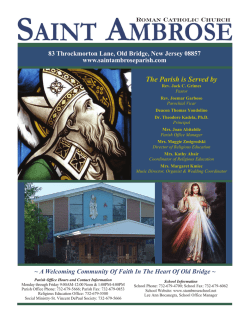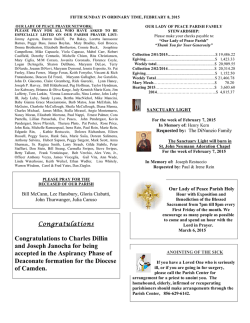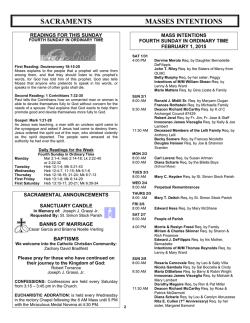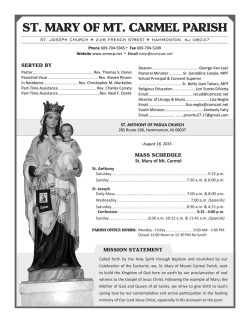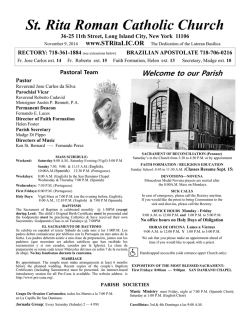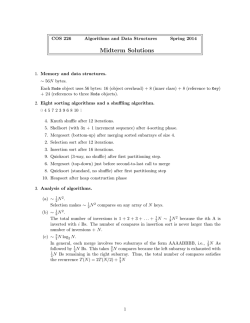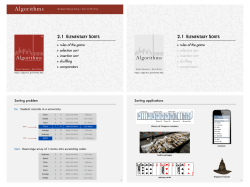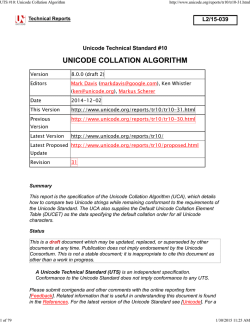
Final Exam Solutions
COS 226
Algorithms and Data Structures
Fall 2012
Final Exam Solutions
1. Analysis of algorithms.
(a) 400 seconds
(b) ∼ 4M R
2. Graphs.
(a) The method marked[v] returns true if and only if there is a directed path from s to v.
(b) E + V , as usual for depth-first search.
(c) V (to initialize the marked[] array).
(d) V 2 . Note that E ≤ V 2 since there are no parallel edges.
3. Graph search.
(a) reverse postorder: 0 1 6 5 2 8 9 4 3 7
(b) preorder: 0 1 6 2 7 8 3 9 4 5
4. Minimum spanning trees.
(a) 10 20 30 40 50 100
(b) x ≤ 110.
(c) y ≤ 60.
(d) z ≤ 80.
5. Shortest paths.
(a) 0 1 5 4
(b) x = 8.0
(c) y > 12.0. (We also accepted y ≥ 12.0.)
1
(d) vertex 2
(e)
v
distTo[] edgeTo[]
3
20.0
2→3
6
35.0
2→6
6. Maximum flow.
(a) 25
(b) A → G → B → C → H → I → J
(c) 25 + 3 = 28
(d) {A, B, C, F, G}
(e) 28
7. String sorting algorithms.
034423221
8. Ternary search tries.
(a) A (7), CAA (5), CGA (4), CGCA (11), TA (8), TGT (12), TT (9)
Final, Fall 2012
(b)
C
7
A
A
T
G
5
A
A
G
C
C
13
4
A
A 11
3
8
T
T
A
A
17
T
T
G
T
0
99
2
A
12
9
9. Knuth-Morris-Pratt substring search.
ABCABABABCAA
A
B
C
0
1
0
0
1
1
2
0
2
1
0
3
3
4
0
0
s
A
B
C
A
4
1
5
0
5
6
0
3
6
1
7
0
7
8
0
3
8
1
9
0
9
1
0
10
10
11
0
0
11
12
5
0
B
A Fall
B 2012
A
B
Final,
C
A
A
10. Boyer-Moore substring search.
M
E
N
D
E
R
O
I
D
O
F
T
H
E
I
D
O
F
R
O
A
F
T
H
E
D
S
W
I
T
H
I
D
O
I
I
T
H
E
F
T
H
E
D
O
F
T
H
E
D
O
F
T
H
A
I
D
O
F
T
H
E
I
D
O
F
T
H
E
E
Final, Fall 2012
11. Regular expressions.
0→3
0
2 → 10
1
3→4
2
3→9
3
5→6
4
6→5
5
6→7
6
9→3
7
8
9
10
11
The
edges
edges.
Here
(
B 8 → 9,| 9 → 10,
( and 10C → 11 are
D the remaining
*
A -transitions
)
*
) is a
drawing of the NFA.
0
1
2
3
4
5
6
7
8
9
10
(
B
|
(
C
D
*
A
)
*
)
3
11
12. Huffman codes.
Final, Fall 2012
(a)
char
B
F
H
I
L
M
S
freq
2
1
3
?
5
15
15
encoding
01111
01110
0110
00
010
10
11
0
0
1
1
0
I
M
0
1
S
1
L
0
1
H
0
F
1
B
(b) 6 ≤ f req(I) ≤ 15.
• Since I is not touched until after merging L with {B, F, H}, f req(I) ≥ f req(L) = 5
and f req(I) ≥ f req({B, F, H}) = 2 + 1 + 3 = 6.
• Since I is merged with {B, F, H, L} instead of M or S, f req(I) ≤ f req(M ) = 15
and f req(I) ≤ f req(S) = 15.
4
13. Data compression.
KXMRDS
8
255
Run-length coding with 8-bit counts for best case inputs of N bits.
A. ∼ 1/4096
The best case is an alternating sequence of 255 0s and 255 1s. Each
sequence of 255 0s (or 255 1s) is encoded with 8 bits (11111111).
B. ∼ 1/3840
C. ∼ 1/2731
8
1
1
8
Run-length coding with 8-bit counts for worst-case inputs of N bits.
D. ∼ 1/2560
The worst case is an alternating sequence of 0s and 1s. Each bit is
encoded with 8 bits (00000001).
E. ∼ 1/320
Huffman coding for best-case inputs of N characters.
The best case is when one character occurs 100% of the time (or all
but a constant number of times), in which case it is encoded using
1 bit.
F. ∼ 1/256
G. ∼ 1/255
H. ∼ 1/128
I. ∼ 1/127
J. ∼ 1/32
8
8
The worst case is when each of the 256 characters occurs with equal
frequency. In this case, each character is encoded using 8 bits.
K. ∼ 8/255
L. ∼ 1/16
M. ∼ 1/8
12
8×3840
LZW coding for best-case inputs of N characters using 12-bit codewords. Recall: no new codewords are added to the table if the table
already has 212 = 4096 entries.
The best case is one 8-bit character, say A, repeated N times. The
table contains 12-bit codewords for A, AA, AAA, and so on, all the
way up to 212 − 256 = 3840 As when the table gets full. After this
point, each sequence of 3840 consecutive As is encoded using only 12
bits.
N. ∼ 1/7
O. ∼ 1/4
P. ∼ 1/2
Q. ∼ 2/3
R. ∼ 1
S. ∼ 3/2
12
8
LZW coding for worst-case inputs of N characters using with 12-bit
codewords. Recall: no new codewords are added to the table if the
table already has 212 = 4096 entries.
The worst case is when the codeword table gets filled up with useless
codewords and then the rest of the message cannot take advantage
of any of the added codewords. An input of 3840 As followed by
N − 3840 Bs would have this property. In this case, each B requires
a 12-bit codeword.
5
T. ∼ 2
U. ∼ 3
V. ∼ 4
W. ∼ 7
X. ∼ 8
14. Algorithm design.
(a) Here is an elegant solution:
• For each string s, form its L circular suffixes and suffix sort them (using LSD radix
sort). Use the lexicographically first sorted suffix as its fingerprint. Two strings are
cyclic rotations of one another if and only if they have the same fingerprint.
• Sort the N fingerprints (using LSD radix sort) and check adjacent fingerprints for
equality. If any two are equal, then output yes; otherwise output no.
(b) The order of growth of the running time is N L2 .
• Explicitly forming the L circular suffixes of a string takes L2 time and space. Sorting
the L suffixes (each of length L) them takes L2 time using LSD radix sort. Doing
this for each string takes a total of N L2 time.
• Sorting the N fingerprints (each of length L) takes N L time using LSD radix sort.
Checking for adjacent entries that are equal also takes N L time.
The running time can be improved to N L in the worst case by implicitly forming the L circular
suffixes of a string and using a linear-time suffix sorting algorithm to compute its fingerprint.
Here is an alternate N L2 time solution:
• Explicitly (or implicitly) form the L circular suffixes of each of the N strings and put
all N L of them into an array.
• Sort the N L strings using LSD radix sort.
• Check for adjacent entries that both are equal and are circular suffixes of different
original strings. The latter check is necessary if one of the original strings happens to
be a nontrivial cyclic rotation of itself, such as stackstack.
15. Reductions.
(a) We need to create a graph G0 such that its longest cycle corresponds to a longest s-t
Final,
2012 Longest
Path
path in G. The intuition is
thatFalladding
an edge
between s and t turns any s-t path of
0
length k in G into a cycle of length k + 1 in G . This doesn’t quite work because there
3
2 the longest
might be a cycle in G that is slonger than1 the length of
s-t path.
Instead of adding an edge between s and t, we add a new path (with new vertices) between s and t of length V . Now, s-t paths in G of length k ≥ 1 are in 1-1 correspondence
with cycles in G0 of length kt + V . Thus,
finding the
longest cycle
in G0 provides the
6
4
5
longest s-t path in G.
s
1
2
3
t
4
5
6
G'
(b) (i) and (iii)
6
© Copyright 2025
